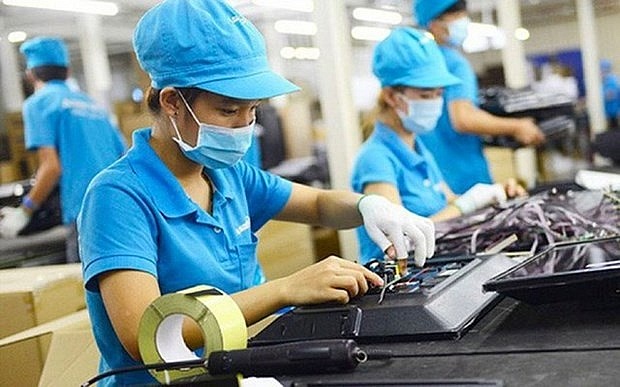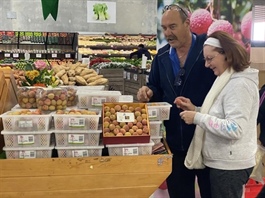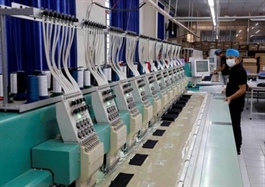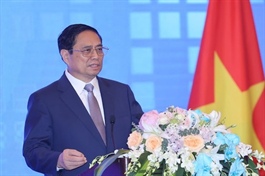Viet Nam’s economy grows 3.72 per cent in first half of 2023
Viet Nam’s economy grows 3.72 per cent in first half of 2023
Viet Nam’s gross domestic product (GDP) expanded 3.72 per cent in the first half of this year, the General Statistics Office (GSO) said yesterday.

Cargo handled at HCM City's Cat Lai Port. Prices of the transportation and warehousing group rose by 7.18 per cent year-on-year, said the General Statistics Office (GSO). — VNA/VNS Photo Hong Dat |
The expansion is nearly the lowest half-year GDP growth in 13 years, only higher than H1 of 2020, which recorded growth of 1.74 per cent.
The information was released at a conference held Thursday in Ha Noi by GSO.
Speaking at a press conference, GSO General Director Nguyen Thi Huong said that the agro-forestry-fishery sector expanded by 3.07 per cent and contributed 9.28 per cent to the GDP growth.
The industry and construction sector grew by 1.13 per cent, leading to an 11.87 per cent increase in growth, and the service sector increased by 6.33 per cent to contribute to 78.85 per cent of the overall expansion.
Huong said that Government policies to promote tourism had contributed to maintaining the growth of the service sector. In the service sector, wholesale and retail increased by 8.49 per cent year-on-year, transportation and warehousing 7.18 per cent, financial, banking and insurance activities 7.13 per cent, accommodation and food services 15.14 per cent.
Huong attributed the GDP growth to the concerted effort of the entire political system, the timely and drastic direction of the Government and the Prime Minister, as well as the efforts of all levels, branches, localities and business community in the whole country.
“Although this is not a high GDP growth rate, inflation is still under control, staying at an appropriate level in the context of Viet Nam facing many difficulties and challenges both at home and abroad. Supply and demand of essential goods are guaranteed, goods procurement and domestic consumption are promoted,” Huong said.
“The agriculture, forestry and fishery sector maintained a stable growth rate, ensuring the supply of food and essential goods. The disbursement progress of public investment capital has improved markedly, the balance of trade in goods has maintained a surplus," she said.
“Besides the achieved results, the economy and society continue to face many difficulties and challenges in the third quarter of 2023, such as changes in the world's economy and politics, energy security, food security, natural disasters, climate change and unpredictable epidemics,” Huong said.
Between January and June, the agro-forestry-fishery sector made up 11.32 per cent of the economy, industry and construction 36.62 per cent, the service sector 43.25 per cent, and taxes on goods (excluding subsidies) 8.81 per cent.
CPI up 3.29 per cent
GSO said the Consumer Price Index (CPI) in June increased by 0.27 per cent month-on-month, up 0.67 per cent against December 2022 and up 2 per cent compared to the same period last year.
GSO General Director Huong attributed the increase in CPI in June to the rises in food prices, increased electricity prices due to prolonged hot weather and adjustment of the average retail price of electricity by Vietnam Electricity (EVN).
Ten of the 11 groups of commodities and services saw prices increase while one decreased.
Those 10 groups of commodities and services witnessing an increase in prices included restaurants and catering services up by 0.57 per cent; culture, entertainment and tourism groups 0.34 per cent; household appliances, tools and equipment 19 per cent; transportation 0.16 per cent; beverage and tobacco 0.16 per cent; garment, hat and footwear 0.11 per cent; education 0.11 per cent; housing and building materials 0.07 per cent; medicine and medical services 0.01 per cent; other goods and services 0.26 per cent.
The only group that saw a decrease in prices was postal and telecommunications, which decreased by 0.23 per cent due to the decrease in the prices of landline and mobile phones.
As for the second quarter, CPI posted a year-on-year rise of 2.41 per cent.
In the quarter, housing and building materials increased by 6.03 per cent; education 5.81 per cent; restaurants and catering services 3.51 per cent; beverages and tobacco 3.43 per cent; culture, entertainment and tourism 2.6 per cent; garment, hats and footwear 2.23 per cent; household appliances, tools and equipment 2.21 per cent; medicine and medical services 0.62 per cent; other goods and services increased 3.36 per cent.
There were two groups seeing a decrease in prices compared to the same period last year, namely post and telecommunications down by 0.47 per cent; transportation down by 8.34 per cent.
On average, in the first six months of 2023, CPI increased by 3.29 per cent over the same period last year; core inflation rose by 4.74 per cent.
Huong attributed the increase in six-month CPI to the rise in prices of education fees, up by 7.95 per cent over the same period last year because some localities in the country have increased education fees since September 2022, causing CPI to increase by 0.49 percentage points.
Prices of housing and construction materials rose by 6.6 per cent over the same period last year, causing CPI to increase by 1.24 percentage points, as the prices of cement, iron, steel, and sand gained in line with the prices of raw materials, besides rising rental prices.
The group of culture, entertainment and tourism also saw prices up by 3.74 per cent due to the control over the COVID-19 pandemic, the increase in people's demand for entertainment and tourism, causing the CPI to increase by 0.17 percentage points.
Prices of food items rose by 3.6 per cent, mainly due to increased consumer demand during the Tet (Lunar New Year) holiday, making CPI up by 0.77 percentage points.
Domestic electricity prices gained by 3.12 per cent due to increased electricity demand and EVN's decision to raise electricity prices by 3 per cent from May 4, 2023, causing CPI to increase by 0.1 percentage point.
























